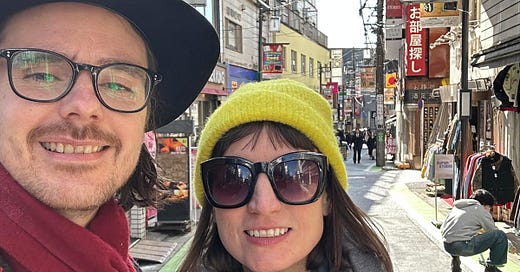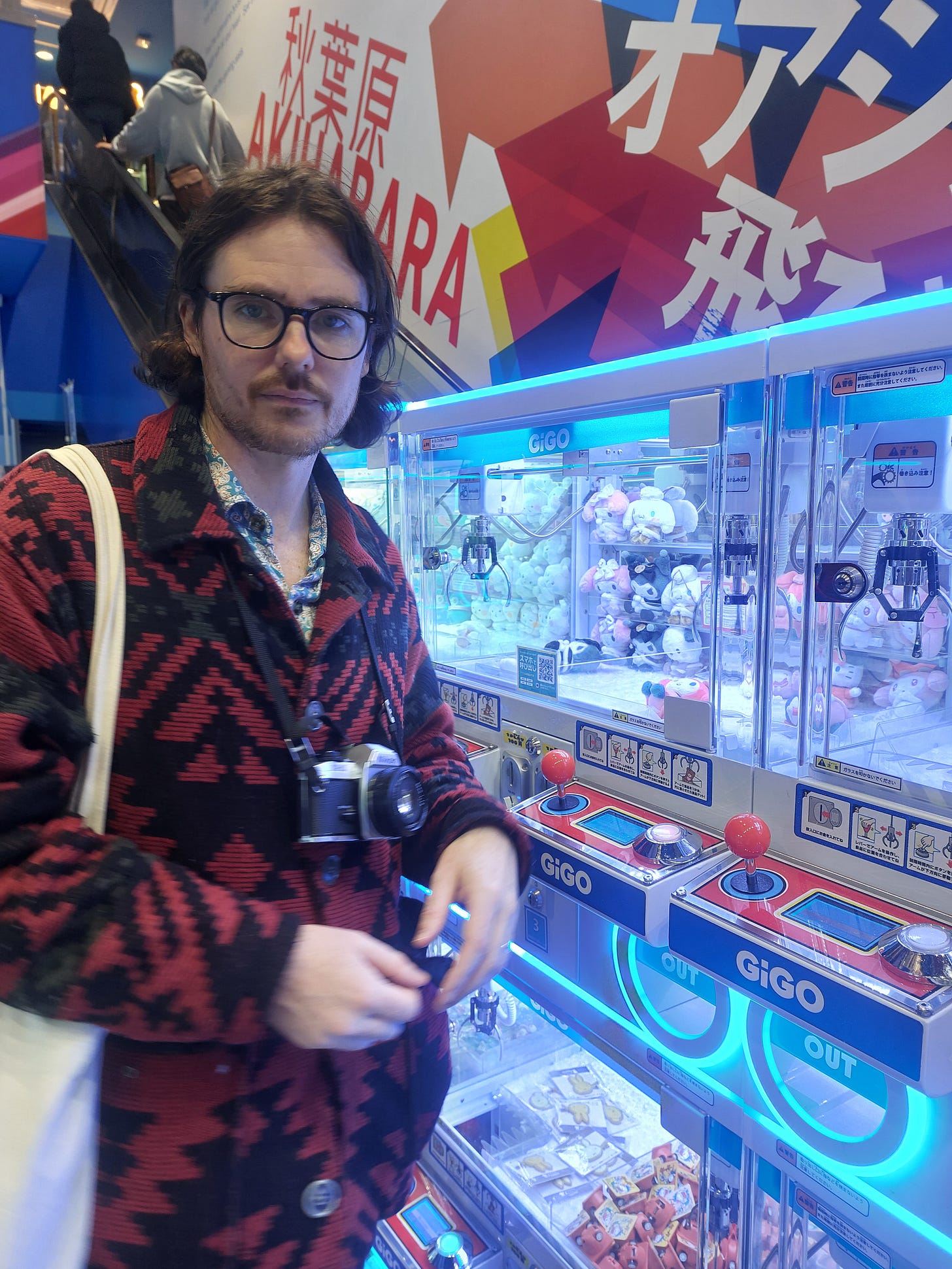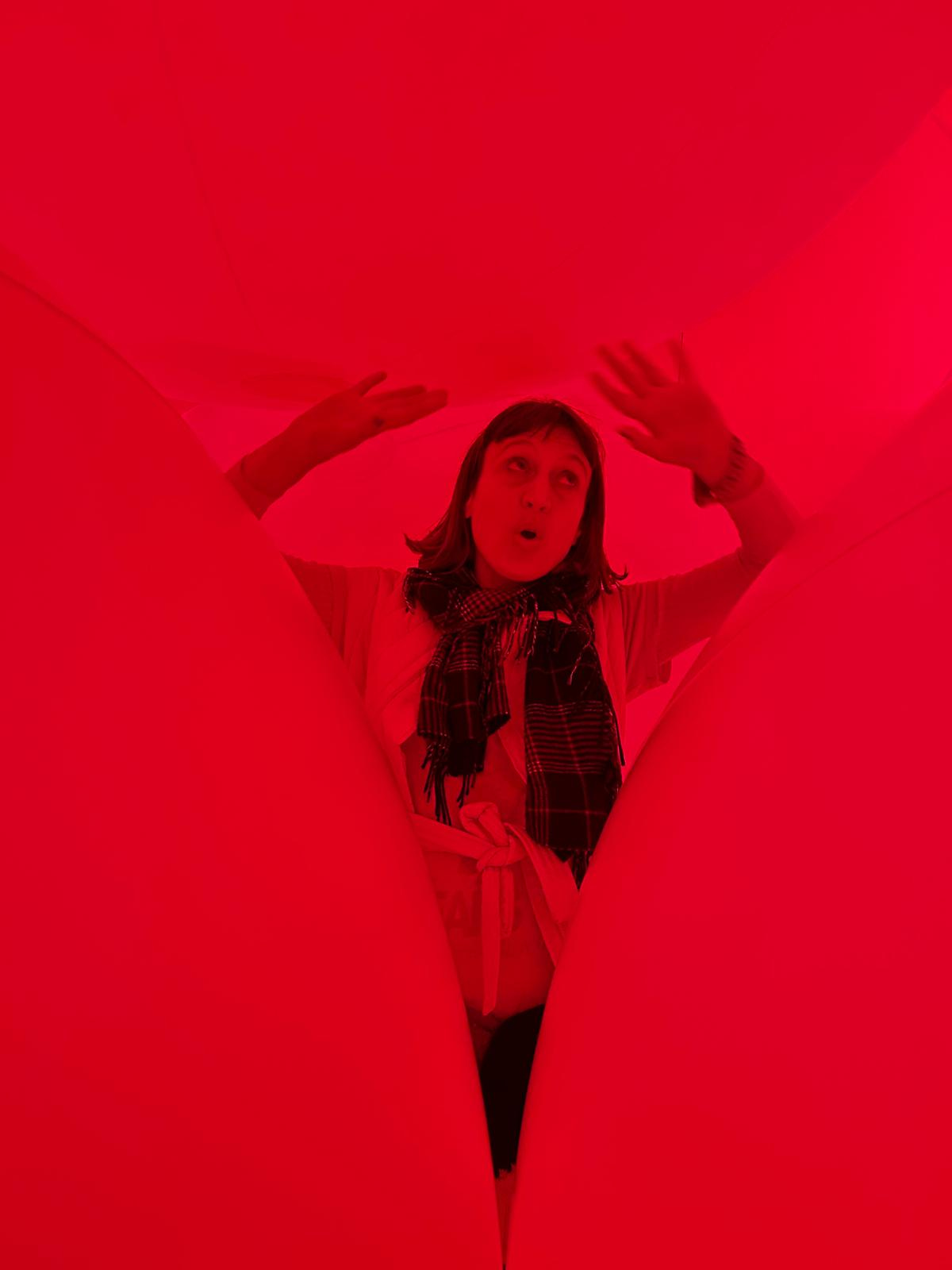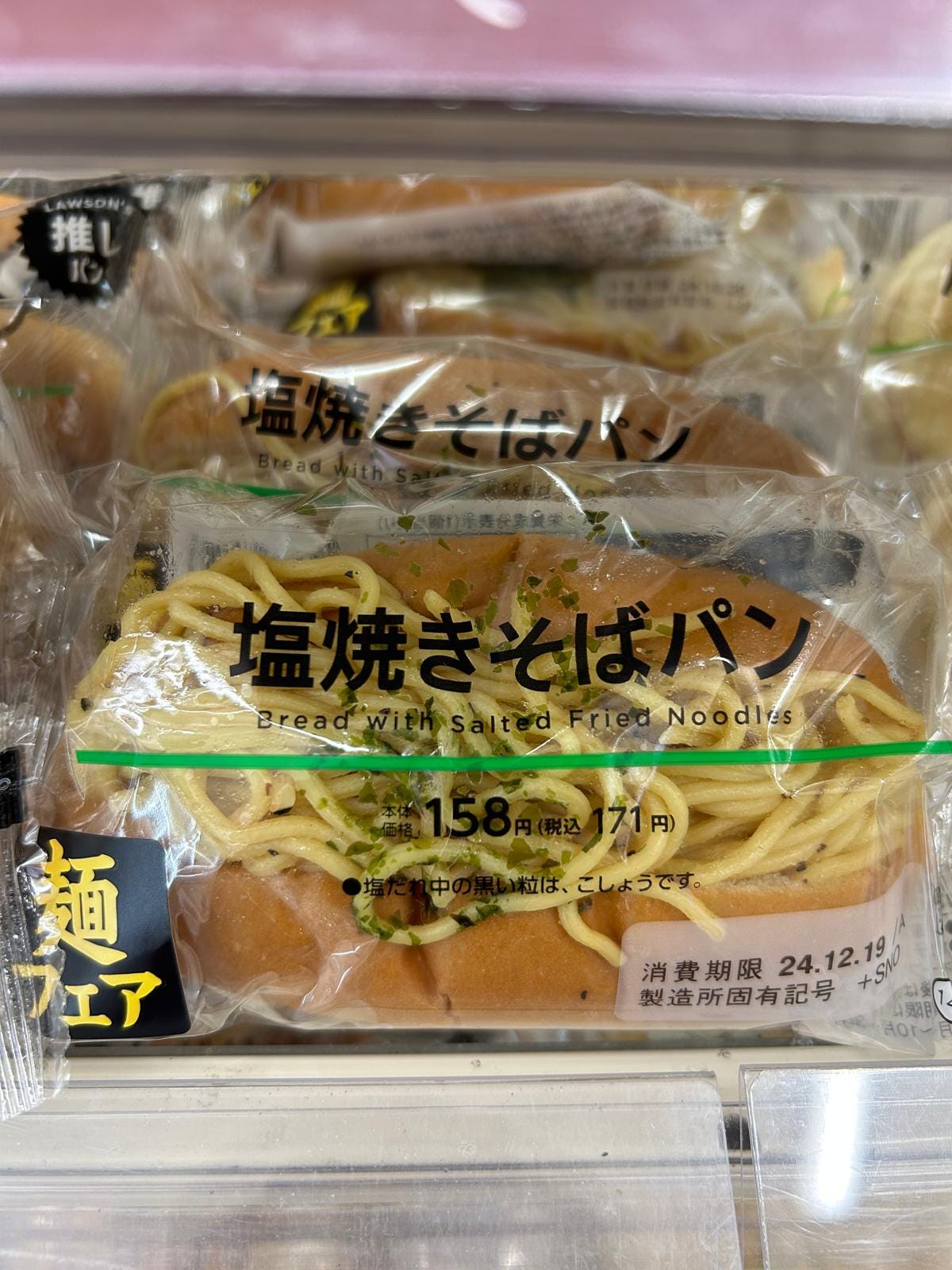Photo: the streets of Shimokatazawa. Refreshingly Japan in the winter is cold but has perennially bright blue skies hence the sunglasses.
4.15 am a week into the trip and we are still - despite our best efforts- living in the surreal kingdom of the jet-lagged. It is the darkest part of the year - solstice was yesterday - and the sun will not rise for another three hours yet here we are wide-eyed, brain as busy as peak-time back at home, bodies awake but aching. Like Bill Murray and Scarlett Johansen in Lost in Translation except there is no New York Bar in the Park Hyatt to drink Suntory whisky in as we overlook the bright lights of Shibuya, instead we lie in the hard yet comfortable bed of a mid-range Western-style hotel in the Golden-Gai and love hotel district of Shinjuku drinking Yellow Label Lipton tea. (The worst of all ‘English’ teas - green tea of course is in abundance here but most hotels, convenience stores and average-supermarkets only offer this the very dregs of the tea-industry.)
Tokyo of the imagination is cutting edge, super-slick, a sci-fi city of the future. Tokyo of the reality is much more nuanced. Much of the aesthetic - interiors, businesses, advertisements- seem instead firmly rooted in the 1980s and ‘90s. Gaudy lights, a lot of mirrors, black marble, a certain flashiness, a certain trashiness. Some of this dated fascination seems intentional, as in the famous Akihabara electronics district where the analogue, console and arcade manner of gaming is revered, some of it less so.
Akihabara is a place of Otaku (geek) community - a companion if not adversary to the disembodied sphere of modern online- gaming. We visit Super Potato - a seven-floor emporium of old-school devices Sega Megastation, Ataris, Gameboys and Neos. Other floors have plastic curtains with ‘No under-18’ signs on them - we do not go behind the curtain. We visit two of the half a dozen Gigos (Sega-created gaming centres). At one there is five floors of crane-claws where you can win Hello Kittys, a vast variety of Pokemon character cuddly toys, and niche Manga figurines, amongst other near-impossible to obtain objects- it is an amped up electrified version of the British sea-side pier and arcade amusement-park. We try for tiny Hello Kitty cuddly toys. The crane picks her up easily: drops her just as easily before the winning exit.
‘It’s a con.’ Billions of yen must go on these claw-games. Strangely addictive - the small burst of a high when picking up the encased object.
Photo: he did not win the Hello Kitty!
At another Gigo a young man grips the metal bar behind him and moves his feet at a super-speed rate to the pacing of neon dance-floor squares. The scent of energy drinks and sweat a pungent miasma.
One of the larger gaming stations is called Panic! and after approximately 40 minutes in Akihabara that name does feel fitting. Adrenaline-spiked by flashing, neon and strip lights, by shooting-sounds, jingles and high-pitched shouts of mechanised encouragement. We decide to take a break at a cafe.
Photo: At the immersive ‘museum’ of Team Lab’s Planets.
We walk up a flight of stairs where the cafe sign is mounted next to a sort of a gun-metal gargoyle figure-head. We have accidentally entered a hostess bar - the women are dressed scantily in velvet Mrs Claus ensembles. The first Mrs Claus seems shocked to see us and requests politely that we stand by the door while she gets a second Mrs Claus who speaks better English to explain the set up.
‘Forty-minutes - cover charge -3,000 yen - all you can drink - you can also have soft drink…’ she says looking at me, ‘we talk to you….usually we are Ninjas but for Christmas…’ she says somewhat apologetically.
The space is like an operating room rather than what you might expect of a bar or cafe, white-tiled and boxy. Two thirty to forty year old men and one just out of teenage years sit on the tiled seats drinking. Each man alone. One pot-bellied man has a bottle of fizz in front of him- the look on his middle-distance stare distinctly not celebratory.
‘Thank you so much, I think we just want a cup of tea somewhere.’
She is Japanese-polite, we are English- polite.
‘Arigato goimaisu, arigato goimaisu. Thank you very much,’ we all say multiple times. As we descend the stairs we hear the many Mrs Claus’s giggling.
We walk on - find a busy, comfy, cosy cafe where the attraction is piled high egg-mayo baguettes and fluffy-whip hot chocolate rather than feigned female attention. The other attraction is smoking - it is a reminder of my youth when cafes were thick with nicotine and your chest tightened within a quarter of an hour of sitting down. We order two Yebisu bottles of beers and sink into a pleather sofa, the wallpaper is thankfully, already a shade of dark-yellow. It is Sunday and no one except us has an alcoholic drink; all seem instead to derive great pleasure from not a single cigarette but a whole-pack chain.
Many spaces which would be dull or chore-like at home feel like tourist attractions here - convenience stores are one - the Isetan Department Store is another. The convenience stores are fascinating zones where the level and variety of ‘junk-food’ on offer is surprising and often not even all junk-y. Sushi that is of a decent level - the type you might get in Itsu or Wasabi in the U.K. but at a much reduced price. High quality as well as frankly weird snacks - vacum-packed fish wrapped in cheese, burrito- style, a bread roll full of salty spaghetti. There is a fantastic selection of Mubi stationery. Plus there’s the really useful stuff (trying to avoid the word convenient there): base layers, thermals, gloves, stylish and cozy house socks, shirts and tie-packs for Salarymen who didn't make it home….
The less useful stuff: face-masks, Pocky, matcha truffles, miniature cars, Manga figurines.
At the other end of the wealth-scale is Isetan a ten- level department store located in famous shopping and party district Shinjuku. It is where the moneyed people of Tokyo spend their yen. We begin to feel quite scruffy as we take the escalators up and down this behemoth. The clientele here are in no obvious way bling but the cuts and quality and style of the fabrics that adorn them cannot but emphasise the healthiness of their bank balances. We go to one of the many cafes inside and drink loose tea and very fresh beer, we are the only genji (foreigners) here. A woman across from us, well-dressed, possibly mid-twenties has an attention-attracting gauze on the bridge of her nose, she is otherwise immaculate - her nose-job brandished as a status symbol rather than a sign of vanity to be ashamed of. Beyond the floors of designer clothing and homewares the real attraction for us is in fact at basement level - the food-court at Isetan is overwhelming and glorious. Each deli-style section offers an elevated version of whatever is sold - whether it be the expected dishes - sushi, bento, and mochi balls in beautiful pastel hues that look too precious to consume - or the sections serving French patisserie, artisanal Christmas biscuits, perfect chocolates, or a single strawberry that somehow resembles a diamond. Even the a humble sandwich is taken to a more dignified level.
Photo: the perfect strawberry at Isetan about to be eaten on a train station bench, it tasted incredible.
Later we visit Harajuku an area that the fashion kids made popularised on an international scale in the nineties and into the noughties, (remember that weird Gwen Stefani early 2000’s move?). Though now the original innovative sartorialists have mostly moved on the streets that define the area are still insanely busy and insanely kawaii. All pastel signage, rainbow-cheese toasties, women in baby-doll dresses and bonnets as greeters outside novelty-item stores. Plus, micro-pigs cuddle rooms, cat cafes, dog cafes, hedgehogs petting-palaces. Doggy in the window style pet shops where the undeniably-adorable puppies look far too young to have been separated from their mothers abound. As a person who cares about animal sentience this is disturbing not cute. There is a man who has around his neck a greasy-looking otter which he feeds kibble-type snacks to every every minute or two, the otter wears a lime- green-top and has a thin chain around its neck. He attempts to encourage passerby into his premises to see more of these imprisoned dam-builders inside.
We swiftly return to the haven of Shimokitazawa - the neighbourhood where we would want to live if we lived in Tokyo, a locus of Japanese sub-culture, calmer than other more famous districts. A thrift-store mecca of low-rises, with large book and stationery stores, great bars, an abundance of live music, good coffee and bakeries, traditional Japanese restaurants that neighbour hybrid venues (tacos with a Japanese twist- Hokkaido corn tortillas, tempeh fillings).
Photo: Godzilla in Shinjuku, of course.
On Christmas eve evening we leave Tokyo - an Uber to Shinjuku station, then a train to Isawa Onsen, an Onsen (hot spring) town ninety minutes into the countryside surrounding the city. The streets are even more manic than we've seen so far, we had heard that Japan, being largely Buddhist, doesn't really celebrate Christmas as we do, and this seems true yet the city is certainly ready to embrace the commercial and party aspect of the holiday. That sexy Mrs Claus costumes line racks of clothing stores, most businesses blast Christmas songs, and fibre-option Christmas tress abound. Fried chicken is also promoted as a Western seasonal tradition (thanks to an awful but clever marketing campaign by KFC in the ‘50s).
Within five minutes seated on the train I am fast asleep battered by both the jet-lag and frenzied force of the megalopolis.
Note: Everybody Wants to Go to Japan - part two - Country- Yamanshi - is now ‘live’ here!










"A certain flashiness, a certain trashiness" makes great lyrics. The basement level of Isetan sounds like heaven.
Well I finally got around to reading this, although I had heard the majority straight from you it is a wonderful read but I feel exhausted for you.